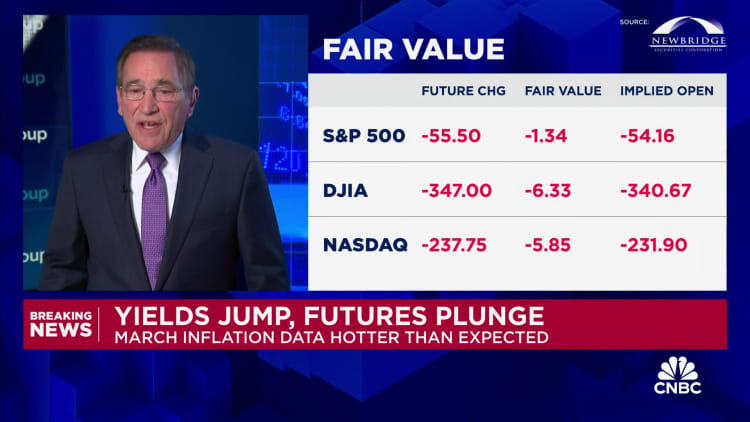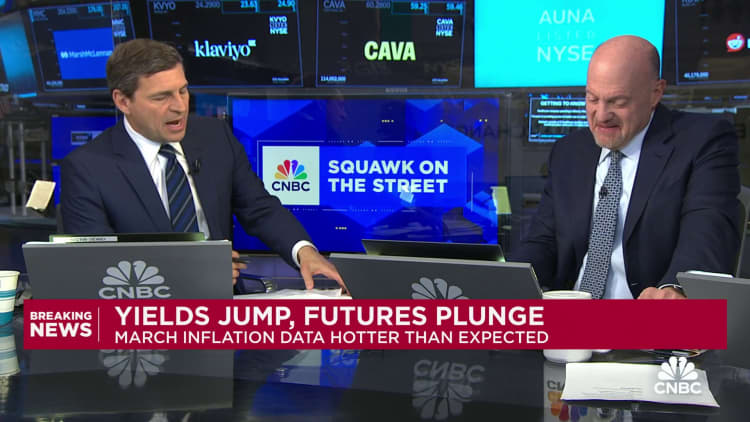Eric
Thayer/Bloomberg
via
Getty
Images
Inflation
jumped
in
March
as
prices
for
consumer
staples
such
as
gasoline
edged
higher
and
those
for
housing
remained
stubbornly
high,
suggesting
inflation
may
be
a
bit
stickier
than
it
seemed
just
a
few
months
ago,
economists
said.
The
consumer
price
index,
a
key
inflation
gauge,
rose
3.5%
in
March
from
a
year
ago,
the
U.S.
Labor
Department
reported
Wednesday.
That’s
up
from
3.2%
in
February.
CPI
measures
how
fast
prices
are
changing
across
the
U.S.
economy.
It
measures
everything
from
fruits
and
vegetables
to
haircuts,
concert
tickets
and
household
appliances.
The
March
inflation
reading
is
down
significantly
from
its
9.1%
pandemic-era
peak
in
2022,
which
was
the
highest
level
since
1981.
However,
it
remains
above
policymakers’
long-term
target,
around
2%.
Progress
in
the
inflation
fight
has
somewhat
flatlined
in
recent
months.
“The
disinflation
has
stalled
out,”
said
Mark
Zandi,
chief
economist
at
Moody’s
Analytics.
“The
big
rock
in
the
way
here
is
the
cost
of
shelter,”
Zandi
said.
While
housing
costs
have
moderated,
they
account
for
the
largest
share
of
the
CPI
inflation
index
and
“are
still
growing
strongly,”
he
said.
Despite
progress
having
stalled,
broader
evidence
doesn’t
suggest
a
renewed
surge
in
inflation
—
though
it
may
take
longer
than
expected
to
bring
the
rate
back
to
target,
economists
said.
In
fact,
underlying
inflation
after
stripping
out
shelter
costs
is
already
back
to
target,
Zandi
said.
“I
still
hold
to
the
view
that
inflation
is
moderating,”
Zandi
said.
“It’s
just
taking
frustratingly
long
to
get
there.”
Household
paychecks
can
buy
more
stuff,
though
Higher
oil
and
gas
prices
take
a
toll
Gasoline
prices
increased
1.7%
from
February
to
March,
the
Bureau
of
Labor
Statistics
said.
This
figure
is
adjusted
to
account
for
seasonal
buying
patterns.
Average
U.S.
pump
prices
were
$3.52
a
gallon
on
April
1,
up
from
$3.35
on
March
4,
according
to
weekly
data
published
by
the
Energy
Information
Administration.

watch
now
The
increase
is
largely
attributable
to
higher
oil
prices.
They’ve
firmed
amid
a
generally
positive
outlook
for
the
global
economy,
meaning
greater
global
oil
demand,
and
controlled
output
among
major
oil-producing
nations,
meaning
there
hasn’t
been
a
glut
of
oil,
economists
said.
Tensions
in
the
Middle
East
may
also
be
playing
a
role,
Hamrick
said.
Higher
gas
prices
may
filter
through
to
higher
prices
elsewhere,
since
they
factor
into
transportation
and
distribution
costs
for
goods
and
even
services
such
as
food
delivery,
he
said.
Higher
energy
prices
are
what
worries
Zandi
most
relative
to
inflation
readings.
It’s
likely
the
upward
trend
will
continue
in
coming
months,
and
the
dynamic
negatively
impacts
consumer
buying
power
and
sentiment,
he
said.
“Nothing
does
more
damage
to
the
economy
more
quickly
than
rising
oil
and
gasoline
prices,”
he
said.
Other
‘notable’
areas
of
inflation
The
BLS
said
that
motor
vehicle
insurance,
medical
care,
recreation
and
personal
care,
in
addition
to
shelter,
were
“notable”
contributors
to
“core”
inflation,
a
reading
that
strips
out
volatile
energy
and
food
prices.
Shelter,
motor
vehicle
insurance,
medical
care,
apparel
and
personal
care
were
notable
contributors
to
monthly
inflation
from
February
to
March,
the
agency
said.
The
overall
monthly
CPI
reading,
0.4%,
was
much
higher
than
the
roughly
0.2%
that
would
be
expected
on
a
consistent
basis
to
bring
inflation
back
to
normal,
economists
said.
“There
is
no
improvement
here;
we’re
moving
in
the
wrong
direction,”
Hamrick
said.
“The
usual
trouble
spots
persist,”
said
Hamrick,
who
additionally
called
out
costs
for
electricity
and
car
maintenance
and
repairs.
Prices
have
fallen
in
some
categories
Meanwhile,
some
consumer
categories
have
seen
improvement.
Prices
fell
for
used
cars
and
trucks,
new
vehicles
and
airline
tickets
between
February
and
March,
for
example.
They’re
also
down
over
the
past
year,
by
2.2%,
0.1%
and
7.1%,
respectively,
according
to
CPI
data.
Lower
prices
for
new
and
used
cars
should
lead
auto
insurance
and
repair
costs
to
fall
as
well,
economists
said.
Grocery
prices
are
another
bright
spot,
they
said.
While
some
categories,
such
as
eggs
and
pork
chops,
have
seen
recent
upward
movement,
the
overall
“food
at
home”
index
stood
at
0%
on
a
monthly
basis
in
both
February
and
March.
“Food
prices
have
come
to
a
standstill,”
Zandi
said.
“For
most
Americans,
the
thing
that
bothers
them
the
most
about
inflation
is
high
food
prices.”
Supply-and-demand
dynamics
At
a
high
level,
supply-and-demand
imbalances
are
what
trigger
out-of-whack
inflation.
For
example,
the
Covid-19
pandemic
disrupted
supply
chains
for
goods.
Americans’
buying
patterns
also
simultaneously
shifted
away
from
services
—
such
as
entertainment
and
travel
—
toward
physical
goods
since
they
stayed
at
home
more,
driving
up
demand
and
fueling
decades-high
goods
inflation.
Additionally,
supply-and-demand
dynamics
in
the
labor
market
pushed
wage
growth
to
the
highest
level
in
decades,
putting
upward
pressure
on
prices
for
services,
which
are
more
wage-sensitive.
Now
that
supply-chain
issues
are
“pretty
close
to
fixed,”
there’s
“little
scope”
for
goods
to
contribute
to
disinflation
moving
forward,
said
Sarah
House,
senior
economist
at
Wells
Fargo
Economics.

watch
now
“You
need
services
to
take
the
mantle
of
disinflation,”
because
goods
have
“petered
out,”
she
added.
Housing
falls
into
the
services
category.
It
accounts
for
the
largest
share
of
the
consumer
price
index,
so
disinflation
in
this
category
would
likely
have
a
large
impact
on
inflation
readings.
So
far,
housing
inflation
has
remained
stubbornly
high
—
even
as
economists
have
predicted
it
would
start
moderating
any
day
given
broadly
positive
trends
in
prices
for
new
tenant
rental
leases,
for
example.
“It
seems
to
be
taking
a
bit
longer
than
people
thought,”
said
Andrew
Hunter,
deputy
chief
U.S.
economist
at
Capital
Economics.
“It’s
coming,”
he
said.
“It’s
just
a
matter
of
when.”
